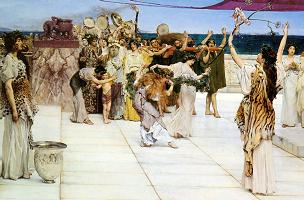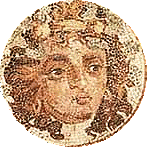DIONUSOS
(Dionysus)
God of Wine, Theater, and the "Life Force"
 Roman Name: Bacchus
Roman Name: BacchusSacred Regions: Thebes Sacred Plant: Grapevines, ivy, pines Totem Animals: Leopards, panthers, goats How to Identify Him: Vine leaves, thyrsus
|
Images of Dionysus, courtesy of Laurel Bowman
In ancient art the last and youngest member of the Olympic pantheon is usually depicted as a bearded man with an ivy crown, though he can be shown as a mask only. He often has a panther near him, or is shown riding on one. In one mosaic from Pompeii, he is shown as a winged god riding on the back of a tiger.
Other depictions show him as a young man, almost feminine, with curly hair, as in the mosaic on the upper left, but the ivy or the grapevines will almost always be there to identify him. The picture inside the table is adapted from Nicolas Bertin's painting of Bacchus and Ariadne, c.1710-15, in which he holds a remarkably modern wine glass!
Dionysus is usually connected to wine and mystic rituals, but that is not all there is to this mysterious god. According to the most common account, Dionysus was born to Zeus and Semele, daughter of the King of Thebes. As usual, once Hera found out she came up with a plan to keep the child from growing up. Our textbook makes an interesting point in the fact that it's not just jealousy this time; as Powell puts it, "It is not surprising that Hera, protectress of the family, would oppose the raging god who excited married women to madness and caused them to forget their duty to husband, family, and community" (275).
The child's troubles didn't end at birth, and Zeus, foreseeing this, asked Hermes to send the child away, either to be raised by his Aunt Ino or else to the Cycladic island of Naxos or to Mount Nyse, where he was raised in the form of a kid (i.e., a baby goat) by nymphs. The mountain place could be the etymological explanation of his name: "the god from Nyse." Then again, the name Dionysus could also mean "child of Zeus" or even "Zeus's limp"! The last would make sense given the fact Dionysus was supposedly incubated inside Zeus's thigh.
As the child god matured his friends were satyrs, nymphs, and other forest creatures, and he would never forget his childhood companions. These, too, are common elements in images of Dionysus, even after he's grown up.
But Hera hadn't forgotten him, and as a last resort she inflicted him with a madness similar to drunkenness that sent him roaming around Greece, Egypt, Asia Minor, and Israel. According to some myths Nysa was the name of the nymph who raised him and not the place, and she was said to be buried in Israel in "Nysa Schitopolis," now known as Bet Shean.
His travels suggest that he is not an original god of Greece but was adapted from other neighboring countries, a foreign origin that would explain why he is a latecomer on the Olympian scene, taking Hestia's place on the divine council.
Another story concerning his birth is connected to Demeter. In this case it is said he was her child, but when he was born the Titans, acting upon Hera's orders, tore him apart. Zeus saved the heart and gave it to Semele to swallow; thus Dionysus was born again. The fact that according to both legends he is twice born is one of the main reasons for his connection to mystic rituals, and, as Powell explains on page 244 of Classical Myth, a parallel with some of the elements of Christianity. Like the grapevine, which must be cut back every year if it is to flourish, Dionysus was cut down only to rise again. His connection to Demeter and this "twice-born" nature made him a part of agricultural rituals and celebrations even before he was known as "god of wine."
While he was in Asia he met the Goddess Cybele. Cybele was another deity of eastern origins who, while initiating him into her Mysteries, cured him of his madness and made him realize his godliness.
Realizing his divine nature at last, he tried to make himself known to others as well, but that never came easy to him. He started by introducing wine to a farmer and his daughter, but when they let their neighbors drink it they thought they had been poisoned! They killed the farmer, and the daughter killed herself in grief. The god, hearing this, avenged his first believers' death by turning the Athenian women mad. Perhaps Hera had furnished him with an example.
The oracle in Delphi explained the problem to the Athenians, who then built a temple to Dionysus and celebrated him as they should. In fact, it was said that between January and July, Dionysus took Apollo's place at Delphi. Dionysus and Apollo are often contrasted with one another, as in Nietzsche's idea of the "Apollonian" and the "Dionysian" sides of our personalities. The stories of horrific end that came to the Minyads (see Powell, page 251), King Pentheus of Thebes, and others like them are examples of how dangerous it is for us to deny this irrational, free side of our own nature. It reminds me of the story of Theseus's son Hippolytus, and how he incurred Aphrodite's wrath by devoting himself wholly to Artemis and denying the power of passionate love. Like the Minyads, he was fundamentally good and chaste, but that didn't save him.
The story about the Athenian farmer is similar to the stories of Pentheus and the Minyads, but it also tells us that once you believe in Dionysus he is a good and protecting god who cares for his followers. If only Hippolytus had been so lucky with his patron, Artemis!
The relationship between women and Dionysus is best described in Euripides' Bacchae, which is quoted at great length in our textbook.
 Because madness is an integral part of Dionysus story and drinking wine
is connected to losing control, Dionysian Festivals have to do with
losing one's self during celebration. According to the famous mythographer Walter Burkert, this
has to happen in a crowd, as a shared experience. It doesn't have to come through being drunk;
the crowds and the ritual itself cause one to lose one's individual self
during the celebration.
Because madness is an integral part of Dionysus story and drinking wine
is connected to losing control, Dionysian Festivals have to do with
losing one's self during celebration. According to the famous mythographer Walter Burkert, this
has to happen in a crowd, as a shared experience. It doesn't have to come through being drunk;
the crowds and the ritual itself cause one to lose one's individual self
during the celebration.
During the festivals there was a parade, as depicted here by Sir Lawrence Alma Tadema in "A Dedication to Bacchus" (Full Screen Image). The believers used to wear clothing that would make them resemble Dionysus's companions: masks and animal skin and leather clothing. They would lead with his symbols, the vine, wine, kids, figs, and the phallus to represent fertility. The worshippers sometimes wore twigs as decoration, which are associated with him like the ivy but which can't have been nearly so comfortable to wear.
The Dionysian celebrations (Bacchanalia, Dionysia) had different schedules around Greece. Some of the uniqueness was created by each city celebrating at her special time, thus remembering her own acceptance of the god.
These celebrations were often associated with the theater was in fact a kind of Bacchic celebration that evolved to what it is today from people wearing goat skins calling themselves "tragoi" and singing dithyrambs. More information on dithyrambs, and on the origins of Greek theater, is available in the Greek Theatre page of East Los Angeles College or, in greater detail, from a multi-page site provided by PBS (to get all the pages, keep clicking on the tiny arrows at the bottom of the screen).
To read more about Dionysus, click here and here for entries from the Encyclopedia Mythica and Perseus, click here for an overview of myths about Dionysus (here referred to, for some mysterious reason, as "Dionysus 2") in capsule form, and here for ancient texts referring to him. You can also find more information from this site on mystery religions and this on-line article on Dionysus: Myth and Ritual in Sources of the Archaic Period from the University of Haifa. You might also want to look at the account of Dionysus's birth as described by Ovid, who does an interesting job of tying in Hera's wrath about Dionysus with an angry prejudice on her part against Thebes in general.
